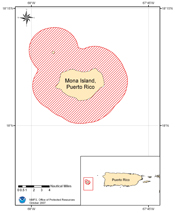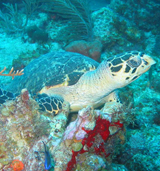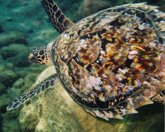Hawksbill Turtle (Eretmochelys imbricata)
Status | Taxonomy | Species Description | Habitat | Distribution |
Population Trends | Threats | Conservation Efforts | Regulatory Overview |
Key Documents | More Info
| Photos
Status
ESA Endangered - throughout its range
Taxonomy
Kingdom: Animalia
Phylum: Chordata
Class: Reptilia
Order: Testudines
Family: Cheloniidae
Genus: Eretmochelys
Species: imbricata
Species Description
The hawksbill turtle is small to medium-sized compared to other sea turtle species. Adults weigh 100-150 lbs (45 to 68 kg) on average, but can grow as large as 200 lbs (91 kg). Hatchlings weigh about 0.5 oz (14 g).
The carapace (top shell) of an adult ranges from 25 to 35 inches (63 to 90 cm) in length and has a "tortoiseshell" coloring, ranging from dark to golden brown, with streaks of orange, red, and/or black. The shells of hatchlings are 1-2 inches (about 42 mm) long and are mostly brown and somewhat heart-shaped. The plastron (bottom shell) is clear yellow. The rear edge of the carapace is almost always serrated, except in older adults, and has overlapping "scutes".
The hawksbill turtle's head is elongated and tapers to a point, with a beak-like mouth that gives the species its name. The shape of the mouth allows the hawksbill turtle to reach into holes and crevices of coral reefs to find sponges, their primary food source as adults, and other invertebrates. Hawksbill turtles are unique among sea turtles in that they have two pairs of prefrontal scales on the top of the head and each of the flippers usually has two claws.
Male hawksbills mature when they are about 27 inches (69 cm) long. Females mature at about 31 inches (78 cm). The ages at which turtles reach these lengths are unknown.
Female hawksbills return to their natal beaches every 2-3 years to nest at night approximately every 14-16 days during the nesting season. A female hawksbill generally lays 3-5 nests per season, which contain an average of 130 eggs. Hawksbill turtles usually nest high up on the beach under or in the beach/dune vegetation on both calm and turbulent beaches. They commonly nest on pocket beaches, with little or no sand.
 Hawksbill Turtle Critical Habitat (click for larger view PDF) |
Habitat
Hawksbill turtles use different habitats at different stages of their life cycle, but are most commonly associated with healthy coral reefs. Post-hatchlings (oceanic stage juveniles) are believed to occupy the "pelagic" environment, taking shelter in floating algal mats and drift lines of flotsam and jetsam in the Atlantic. In the Pacific, the pelagic habitat of hawksbill juveniles is unknown. After a few years in the pelagic zone, small juveniles recruit to coastal foraging grounds; their size at recruitment is approximately 8-10 inches (20-25 cm) in carapace length in the Atlantic and about 15 inches (38 cm) in carapace length in the Pacific. This shift in habitat also involves a shift in feeding strategies, from feeding primarily at the surface to feeding below the surface primarily on animals associated with coral reef environments. Here, juveniles begin feeding on a varied diet. In the Caribbean, as hawksbills grow they begin exclusively feeding on only a few types of sponges. However, in the Indo-Pacific, hawksbills continue eating a varied diet that includes sponges, other invertebrates, and algae.
The ledges and caves of coral reefs provide shelter for resting hawksbills both during the day and at night. Hawksbills are known to inhabit the same resting spot night after night. Hawksbills are also found around rocky outcrops and high energy shoals, which are also optimum sites for sponge growth. They are also known to inhabit mangrove-fringed bays and estuaries, particularly along the eastern shore of continents where coral reefs are absent.
Critical habitat was designated in 1998 for hawksbill turtles in coastal waters surrounding Mona and Monito Islands, Puerto Rico.
 Hawksbill Turtle (Eretmochelys imbricata) Photo: Michelle T. Scharer |
Distribution
Hawksbill turtles are circumtropical, usually occurring from 30° N to 30° S latitude in the Atlantic, Pacific, and Indian Oceans and associated bodies of water. Hawksbills are widely distributed throughout the Caribbean Sea and western Atlantic Ocean, regularly occurring in southern Florida and the Gulf of Mexico (especially Texas), in the Greater and Lesser Antilles, and along the Central American mainland south to Brazil. Hawksbills do not occur in the Mediterranean Sea.
Within the U.S., hawksbills are most common in Puerto Rico and its associated islands and in the U.S. Virgin Islands. In the continental U.S., the species is recorded from all the Gulf States and along the east coast as far north as Massachusetts, but sightings north of Florida are rare. Hawksbills are observed in Florida on the reefs off Palm Beach, Broward, Miami-Dade, and Monroe Counties. Texas is the only other U.S. state where hawksbills are sighted with any regularity. Most sightings involve post-hatchlings and juveniles. These small turtles are believed to originate from nesting beaches in Mexico.
Along the Pacific Rim, hawksbills nest sporadically in the southern part of the Baja peninsula, while sightings of juveniles and sub-adults foraging along the coast occur more regularly. Hawksbills rarely occur along the Pacific Central American coast; limited nesting has been documented on the Pacific coast of Costa Rica (Gaos et al. 2006).
Within the Central Pacific, nesting is widely distributed, though scattered and in very low numbers. The largest concentrations of nesting hawksbills in the Pacific occur on remote oceanic islands of Australia and in the Indian Ocean (e.g., Republic of Seychelles). Foraging hawksbills have been reported from virtually all of the island groups of Oceania and from the Galapagos Islands in the eastern Pacific to the Republic of Palau in the western Pacific (Witzell 1983, Prichard 1982a, b). Along the far western and southwestern Pacific, hawksbills nest on islands and mainland Asia from China and Japan, through the Philippines, Malaysia, and Indonesia to Papua New Guinea, the Solomon Islands (McKeown 1977), and Australia (Limpus 1982).
Research indicates adult hawksbill turtles are capable of migrating long distances between nesting beaches and foraging areas, which are comparable to migrations of green and loggerhead turtles. In the Atlantic, a female hawksbill tagged at Buck Island Reef National Monument in the U.S. Virgin Islands traveled 1,160 miles (1,866 km) to the Miskito Cays in Nicaragua (Spotila 2004).
Population Trends
Hawksbills are solitary nesters and, thus, determining population trends or estimates on nesting beaches is difficult. The largest populations of hawksbills are found in the Caribbean, the Republic of Seychelles, Indonesia, and Australia.
The most significant nesting within the U.S. occurs in Puerto Rico and the U.S. Virgin Islands, specifically on Mona Island and Buck Island, respectively. Each year, about 500-1000 hawksbill nests are laid on Mona Island, Puerto Rico (Diez and van Dam 2006) and another 100-150 nests on Buck Island Reef National Monument off St. Croix in the U.S. Virgin Islands (Z. Hillis-Starr. pers. comm.). Nesting also occurs on other beaches in St. Croix and on St. John, St. Thomas, Culebra Island, Vieques Island, and mainland Puerto Rico. Within the continental U.S., nesting is restricted to the southeast coast of Florida and the Florida Keys, but nesting is rare in these areas. No nesting occurs on the west coast of the U.S. mainland. In the U.S. Pacific, hawksbills nest only on main island beaches in Hawaii, primarily along the east coast of the island of Hawaii. Hawksbill nesting has also been documented in American Samoa and Guam.
In addition to nesting beaches in the U.S. Caribbean, hawksbills nest at numerous other sites throughout the Caribbean, with the majority of nesting occurring in Mexico and Cuba. In Mexico, about 2,800 hawksbills nest in Campeche, Yucatán, and Quintana Roo each year (Spotila 2004). Lutz et al. estimate the number of adult hawksbills living in the Caribbean today is 27,000 (2003).
The largest nesting population of hawksbills appears to occur in Australia. Approximately 2,000 hawksbills nest on the northwest coast of Australia and about 6,000 to 8,000 off the Great Barrier Reef each year (Spotila 2004). Additionally, about 2,000 hawksbills nest each year in Indonesia and 1,000 in the Republic of Seychelles (Spotila 2004).
Threats
Hawksbills face threats on both nesting beaches and in the marine environment. The primary global threat to hawksbills is habitat loss of coral reef communities. Coral reefs are vulnerable to destruction and degradation caused by human activities. Humans can alter coral reefs either gradually (i.e., pollution can degrade habitat quality) or catastrophically (e.g., toxic spills and vessel groundings). Recent evidence suggests that global climate change is negatively impacting coral reefs by causing higher incidences of coral diseases, which can ultimately kill entire coral reef communities. Hawksbill turtles rely on coral reefs for food resources and habitat. As these communities continue to decline in quantity and quality, hawksbills will have reduced foraging opportunities and limited habitat options.
Historically, commercial exploitation was the primary cause of the decline of hawksbill sea turtles. There remains a continuing demand for the hawksbill's shell as well as other products, including leather, oil, perfume, and cosmetics. The British Virgin Islands, Cayman Islands, Cuba, Haiti, and the Turks and Caicos Islands (U.K.) all permit some form of legal take of hawksbill turtles. In the northern Caribbean, hawksbills are directly harvested primarily for their carapace, which is often carved into hair clips, combs, jewelry, and other trinkets. Additionally, hawksbills are harvested for their eggs and meat while whole stuffed turtles are sold as curios in the tourist trade. Hawksbill products are openly available in the Dominican Republic and Jamaica despite a prohibition on harvesting hawksbills and eggs (Fleming 2001).
In the Pacific, directed harvest of nesting females and eggs on the beach and hawksbills in the water is still widespread. Directed take is a major threat to hawksbills in American Samoa, Guam, the Republic of Palau, the Commonwealth of the Northern Mariana Islands, the Federated States of Micronesia, and the Republic of the Marshall Islands (NMFS and USFWS 1998). In addition to directed harvest, increased human presence is a threat to hawksbills throughout the Pacific. In particular, increased recreational and commercial use of nesting beaches, beach camping and fires, litter and other refuse, general harassment of turtles, and loss of nesting habitat from human activities negatively impact hawksbills.
Incidental capture in fishing gear, primarily gillnets, and vessel strikes also adversely affect this species' recovery. For more information, please visit our threats to marine turtles page.
Conservation Efforts
The highly migratory behavior of hawksbills makes them shared resources among many nations. Conservation efforts for hawksbill populations in one country may be jeopardized by activities in another. Therefore, protecting hawksbill sea turtles on U.S. nesting beaches and in U.S. waters alone is not sufficient to ensure the continued existence of the species.
Hawksbill turtles are protected by various international treaties and agreements as well as national laws. They are listed in Appendix I of the Convention on International Trade in Endangered Species of Wild Flora and Fauna (CITES), which means that international trade of this species is prohibited. The IUCN ![]() classifies hawksbills as critically endangered. Hawksbills are listed in Appendices I and II of the Convention on Migratory Species (CMS
classifies hawksbills as critically endangered. Hawksbills are listed in Appendices I and II of the Convention on Migratory Species (CMS ![]() ) and are protected under the following auspices of CMS: the Memorandum of Understanding on the Conservation and Management of Marine Turtles and their Habitats of the Indian Ocean and South-East Asia (IOSEA) and the Memorandum of Understanding Concerning Conservation Measures for Marine Turtles of the Atlantic Coast of Africa. Hawksbills are also protected under Annex II of the Specially Protected Areas and Wildlife (SPAW
) and are protected under the following auspices of CMS: the Memorandum of Understanding on the Conservation and Management of Marine Turtles and their Habitats of the Indian Ocean and South-East Asia (IOSEA) and the Memorandum of Understanding Concerning Conservation Measures for Marine Turtles of the Atlantic Coast of Africa. Hawksbills are also protected under Annex II of the Specially Protected Areas and Wildlife (SPAW ![]() ) Protocol of the Cartagena Convention. Additionally, the U.S. is a party to the Inter-American Convention for the Protection and Conservation of Sea Turtles (IAC
) Protocol of the Cartagena Convention. Additionally, the U.S. is a party to the Inter-American Convention for the Protection and Conservation of Sea Turtles (IAC ![]() ), which is the only binding international treaty dedicated exclusively to marine turtles.
), which is the only binding international treaty dedicated exclusively to marine turtles.
In the U.S., NOAA's National Marine Fisheries Service (NMFS) and the U.S. Fish and Wildlife Service (USFWS) have joint jurisdiction for marine turtles, with NMFS having the lead in the marine environment and USFWS having the lead on the nesting beaches. Both federal agencies, and a number of state agencies, have promulgated regulations to eliminate or reduce threats to sea turtles. In the Atlantic and Gulf of Mexico, NMFS has required measures (e.g., gear modifications, changes to fishing practices, and time/area closures) to reduce sea turtle bycatch in pelagic longline, mid-Atlantic gillnet, Chesapeake Bay pound net, and southeast shrimp and flounder trawl fisheries.
NMFS has worked closely with the shrimp trawl fishing industry to develop turtle excluder devices (TEDs) to reduce the mortality of sea turtles incidentally captured in shrimp trawl gear. TEDs that are large enough to exclude even the largest sea turtles are now required in shrimp trawl nets. Since 1989, the U.S. has embargoed shrimp harvested in a manner that adversely affects sea turtles. The import ban does not apply to nations that have adopted sea turtle protection programs comparable to that of the U.S. (e.g., require and enforce the use of TEDs) or to nations where incidental capture in shrimp fisheries does not present a threat to sea turtles (e.g., nations that fish for shrimp in areas where sea turtles do not occur). The U.S. Department of State (DOS) is the principal implementing agency of this law, while NMFS serves as technical advisor. NMFS has provided extensive TED training throughout the world.
In 2003, NMFS developed the Strategy for Sea Turtle Conservation and Recovery in Relation to Atlantic and Gulf of Mexico Fisheries (Strategy) to evaluate and address domestic sea turtle bycatch comprehensively across jurisdictional (i.e., state and Federal) and fishing sector (i.e., commercial and recreational) boundaries on a per-gear basis in fisheries of the Atlantic and Gulf of Mexico.
NMFS is involved in cooperative gear research projects designed to reduce sea turtle bycatch in the Gulf of Mexico and Atlantic pelagic longline fisheries, the Hawaii-based deep set longline fishery, the Atlantic sea scallop dredge fishery, the Chesapeake Bay pound net fishery, and non-shrimp trawl fisheries in the Atlantic and Gulf.
Regulatory Overview
The hawksbill turtle was listed under the Endangered Species Act (ESA) as endangered in 1970.
In 1998, NMFS designated critical habitat for hawksbill turtles to include the coastal waters surrounding Mona and Monito Islands, Puerto Rico.
Key Documents
(All documents are in PDF format.)
| Title | Federal Register | Date |
|---|---|---|
| 5-Year Review | n/a | 08/31/2007 |
| TRAFFIC Report - Turning the Tide: Exploitation, Trade and Management of Marine Turtles in the Lesser Antilles, Central America, Colombia and Venezuela | n/a | 2006 |
| Critical Habitat - Mona and Monita Islands, Puerto Rico | 63 FR 46693 | 06/02/1998 |
| Recovery Plan - U.S. Pacific | 63 FR 28359 | 05/22/1998 |
Status Review of Sea Turtles Listed Under the Endangered Species Act of 1973 |
61 FR 17 | 01/02/1996 |
TED Regulations for Shrimp Trawls |
57 FR 57348 | 12/04/1992 |
| Recovery Plan - U.S. Caribbean, Atlantic, and Gulf of Mexico | 57 FR 38818 | 08/27/1992 |
| ESA Listing Rule | 35 FR 8491 | 06/02/1970 |
- Kids' Times: Hawksbill Sea Turtle [pdf]
- NOAA's National Marine Sanctuaries Encyclopedia
- NOAA Tech. Memo. NMFS-OPR-5: Evaluation of a Fisheries Model for the Harvest of Hawksbill Sea Turtles, Eretmochelys imbricata, in Cuba [pdf] [7.0 MB]
- TRAFFIC North America

- U.S. Fish and Wildlife Service Hawksbill Turtle Species Profile
- Sea Turtle Recovery Planning
- Marine Turtle Related Links
Literature Cited
- Clifton, K., D.O. Cornejo, and R.S. Felger. 1982. Sea turtles of the Pacific Coast of Mexico. Pages 199-209 in K.A. Bjorndal (ed.), Biology and Conservation of Sea Turtles. Smithsonian Institution Press, Washington, D.C.
- Diez, C. E. and R.P. van Dam. 2006. Hawksbill turtle nesting beach habitat restoration on Mona Island, Puerto Rico: Research report for 2005.
- Fleming, E.H. 2001. Swimming Against the Tide: Recent surveys of exploitation, trade, and management of marine turtles in the Northern Caribbean. TRAFFIC North America. Washington, D.C.
- Gaos, A., R. Arauz, and I. Yañez. 2006. Hawksbill turtles on the Pacific coast of Costa Rica. Marine Turtle Newsletter 112:14.
- Limpus, C.J. 1982. The status of Australian sea turtle populations. Pages 297-303 in K.A. Bjorndal (ed.), Biology and Conservation of Sea Turtles. Smithsonian Institution Press, Washington, D.C.
